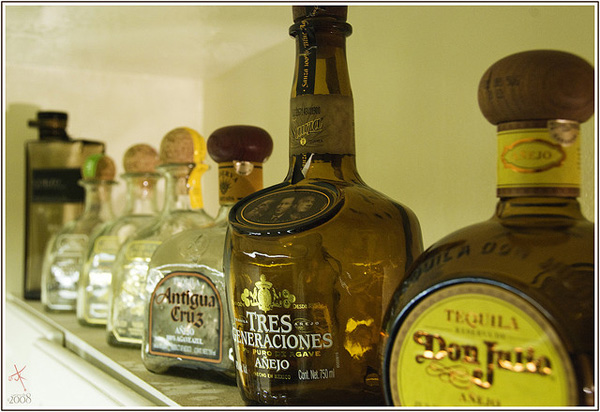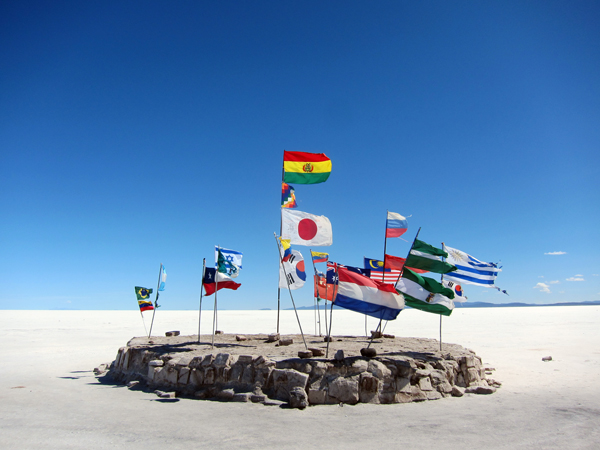
Tequila comes from the fermented juices of the blue agave plant. The agave is not a cactus as many people believe, but actually a member of the lily family. By Mexican law, authentic Tequila is only that which is produced in certain regions, such as the western state of Jalisco. It is not to be confused with Mezcal, which can be made from any of the numerous species of agave that grow in Mexico.
The Mule and the Pineapple
Authentic Tequila is produced according to age-old traditions. The agave is sometimes grown for as long as ten years, before the flower stalk is harvested by the Tequila farmer (‘campesino’), with a special knife. Growth is redirected, causing the bulb beneath to swell and fill with liquid. Owing to its spiky, green appearance, this bulb is often referred to as the ‘piña’, or ‘pineapple’. The piña is then put in a stone trough, and crushed by a large boulder dragged around in circles behind a mule.
Tequila Varieties
A number of varieties of Tequila are available on the market, but there are strict rules governing what can be sold as authentic Tequila. True Tequila must be bottled in Mexico, and only water can be added to the ‘honey water’ harvested from the agave bulb. Other distillers produce ‘mixto’ varieties, where the juice is sweetened with cane sugars and other additives.
Tequila is generally either gold or silver in colour. Silver Tequila usually spends a short period (two months or so) maturing in stainless steel barrels. Gold on the other hand is kept in oak barrels for as long as four years. The colour comes from added flavourings, including sherry, caramel, coconut and occasionally prunes!
Distillers will often age their Tequila for a very specific period of time. Older Tequilas are often known as ‘añejo’, while those that spend a shorter time in barrels are called ‘reposado’, meaning ‘rested’.
Pickled Worms
Tequila is often depicted with a worm floating in the bottle. There is a tradition surrounding the worm, which delivers a mean kick if eaten! It’s even been suggested to have hallucinogenic effects.
In fact, if you find a worm in the bottle, you can be pretty sure that you’re not drinking Tequila, but actually Mezcal instead. The ‘worm’ is the larvae of one of the two moths that lives under the shelter of the agave. Traditionally, it allowed customers to see the quality of the final product – if the worm was successfully preserved, then it meant you were drinking the good stuff.
The Drink of Ancient Kings
Tequila first existed way back two thousand years ago, when it was discovered by the ancient Aztecs. They found that when the agave plant was left to rot in the sun the juice would condense into a milky, white fluid, with relaxing properties.
We know this early form of Tequila by the Spanish name of ‘pulque’… but the Aztecs called it ‘octili poliqhui’. Only the Aztec rulers were permitted to drink the pulque – as well as the occasional captured warrior, during sacrificial ceremonies.
The Arrival of the Spanish
When the Spanish arrived in Mexico in the 16th Century, it wasn’t just the gold they took away. The conquistadores soon stumbled across this strange alcoholic beverage. It didn’t catch on at first, as strong wines and brandy were often being shipped over from Europe, and this pulque was no stronger than a mild beer.
Later on though, the Spaniards discovered that baking the agave pulp sweetened the juices, which in turn boosted the fermentation process. Soon, tavernas everywhere were selling this new Mezcal wine.
Soon a number of rogue distilleries began selling their own Mezcal, despite the Spanish royal family’s attempts to ban the drink. Eventually the crown conceded though, and in the 17th century an official charter was granted to a small town by the name of Tequila.
Then in 1795, a man by the name of José Cuervo became the first to distill the Mezcal wine, producing the Tequila we know and love today.
The Twentieth Century and Beyond
Trade was slow at first, and although Tequila sold well in Mexico, very little was exported to the rest of the world. It was only by chance that in the 1940s, a number of American celebrities and film stars began experimenting with Tequila in cocktails. It is rumoured that Bing Crosby began importing it back from Mexico himself, lorry-loads at a time!
Before long, Tequila-infused drinks like the Margarita and the Tequila Sunrise were becoming the latest hot trend, eventually working their way into every cocktail bar in the world.
Nowadays, Tequila enjoys a booming trade. The world’s most popular brand is still made by José Cuervo, at his classic distillery at La Rojena in the town of Tequila. It’s a must-see attraction for anyone on a holiday to Mexico – you can even ride aboard the Tequila Express from nearby Guadalajara, to visit this quaint old town of agave farmers and distillers.
—
About the Author – Richard Morten is a freelance writer and musician based in Bristol. He regularly contributes to a number of local newspapers, online journals and reference sites, as well as taking editorial roles on two regular publications. Richard’s work reflects strong interests in travel, culture, music and philosophy.














